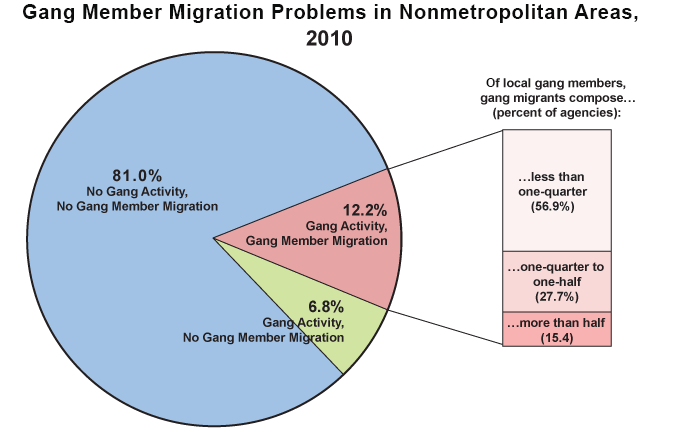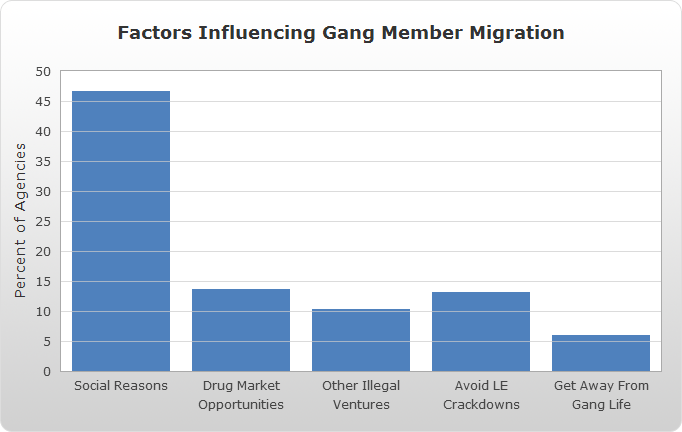Gang Member Migration
Prevalence of Gang Member Migration
In 2010, respondents provided information regarding the presence of gang members who have migrated to their jurisdictions.
Gang member migration refers to the movement of actively involved gang youth from other U.S. jurisdictions to the respondents’ jurisdictions.
- Among agencies with an ongoing gang problem, the majority (71 percent) reported the presence of gang member migrants.
- Respondents serving larger cities and suburban counties were significantly more likely to report gang member migrants than were respondents in smaller areas (74 percent versus 65 percent).
- Approximately half (51 percent) of the agencies reported that their local gang problems emerged well before the arrival of gang member migrants.
Likelihood of Gang Member Migration in Nonmetropolitan Areas
Herein, “nonmetro” refers to police and sheriffs’ departments in the NYGS sample that are located outside of metropolitan areas, where gang activity is largely and historically concentrated.
- In 2010, gang member migration to nonmetro areas was not common or extensive.
- The left-hand portion of the figure below shows that a large majority (81 percent) of nonmetro agencies experienced neither gang activity nor gang member migration, compared with just 12 percent of nonmetro agencies experiencing both.
- The right-hand portion of the figure below shows that when gang member migrants are noted, they frequently compose only a small fraction of total gang membership size—most often, they make up less than 25 percent.
- On the whole, these results strongly suggest that gang member migration is far more the exception than the rule outside metropolitan areas. These findings also support empirical research demonstrating that a community’s gang problem—however affected from other areas—is primarily and inherently homegrown and localized in composition.
| Percent of Jurisdictions Reporting Migration | |
|---|---|
| Gang Activity, Gang Member Migration | 12.2% |
| Gang Activity, No Gang Member Migration | 6.8% |
| No Gang Activity, No Gang Member Migration | 81.0% |
| Of local gang members, gang migrants compose. . . | Percent of Agencies |
|---|---|
| . . .less than one-quarter | 56.9% |
| . . .one-quarter to one-half | 27.7% |
| . . .more than half | 15.4% |
Influential Factors on Gang Member Migration
The reasons gang members migrate can be grouped into two categories:
- Illegitimate reasons, including drug distribution and other illegal activities, recruiting members, and avoiding law enforcement.
- Legitimate or “social” reasons, including concerns and efforts to improve quality of life, including moves with family for employment and/or educational opportunities.
Respondents provided information regarding the influential factors on gang member migration in their jurisdictions in 2010.
- Respondents rated a number of factors pertaining to their influence on gang member migration in their jurisdictions.
- The figure below shows the percentage of agencies that rated the listed factor at the highest value possible.
- Overall, respondents decisively and, statistically speaking, significantly rated social reasons as more influential than all other factors.
- This distinct finding was observed repeatedly regardless of area type, region, population size, length of gang problem, etc.
- Of modest influence were such illegitimate factors as drug distribution and other illegal ventures.
| Percent of Agencies | |
|---|---|
| Social Reasons | 46.7% |
| Drug Market Opportunities | 13.6% |
| Other Illegal Ventures | 10.4% |
| Avoid LE Crackdowns | 13.2% |
| Get Away From Gang Life | 6.0% |
Analysis for this section pertains only to law enforcement agencies reporting gang problems. Please see the Prevalence of Gang Problems section.
« PreviousTable of Contents Next »
Suggested citation: National Gang Center. National Youth Gang Survey Analysis.
Retrieved [date] from https://nationalgangcenter.ojp.gov/survey-analysis.



